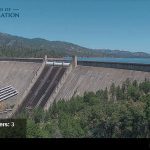- Basin storage has fallen to historic lows as drought persists.
- Post-2026 operating rules remain unresolved among basin states.
- Tribes, cities, and agriculture face growing pressure over allocations.
- Congress continues to fund drought response and oversee basin programs.
Saturday, November 22, 2025 — On November 19, 2025, the Congressional Research Service released a detailed update on how the Colorado River is managed. The report describes a system facing more than two decades of drought, an over-allocated river, and growing competition among states, tribes, farms, and cities.
released a detailed update on how the Colorado River is managed. The report describes a system facing more than two decades of drought, an over-allocated river, and growing competition among states, tribes, farms, and cities.
The Colorado River Basin covers more than 246,000 square miles across seven states and Mexico. Much of the system is operated by the Bureau of Reclamation under a century’s worth of compacts, statutes, court decisions, and international agreements. The foundation of this framework is the 1922 Colorado River Compact, which divided the river into two basins and apportioned 7.5 million acre-feet to each basin. A later treaty guaranteed Mexico another 1.5 million acre-feet.
These numbers rested on assumptions about the river’s natural flow that were higher than today’s observed reality. Since 2000, annual flows have often been far below historic averages. Lake Mead and Lake Powell have dropped to extremely low levels, threatening water supply and hydropower generation.
A Legal Framework Built Over a Century.
The Law of the River.
The term “Law of the River” refers to the combined compacts, statutes, treaties, Supreme Court rulings, operating criteria, and administrative decisions that govern every aspect of the river’s use. It began with the 1922 Compact, which divided the river at Lee Ferry and required the Upper Basin to deliver at least 75 million acre-feet over any ten-year period to the Lower Basin.
Boulder Canyon Project Act.
Congress approved the compact in 1928 and authorized construction of Hoover Dam. The act also allocated the Lower Basin’s water among California, Arizona, and Nevada and designated the Secretary of the Interior as the water master for all deliveries below Hoover Dam.
1944 Treaty With Mexico.
The treaty committed the United States to deliver 1.5 million acre-feet a year to Mexico. During shortages, Mexico may take proportional reductions.
Arizona v. California.
In 1963, the Supreme Court affirmed the Secretary of the Interior’s authority to manage Lower Basin deliveries and ruled that apportionments apply to the Colorado River’s main channel, not its tributaries.
Upper Basin Compact and Storage Projects.
The Upper Basin Compact of 1948 allocated water among Colorado, Utah, Wyoming, and New Mexico and recognized a portion for Arizona’s Upper Basin region. Subsequent federal legislation authorized major storage projects, including Glen Canyon Dam, Flaming Gorge Dam, the Navajo Unit, and the Aspinall Unit.
1968 Colorado River Basin Project Act.
Congress authorized the Central Arizona Project and established drought shortage priorities that placed early and deep reductions on Arizona. The act also required long-range coordinated operations for the river’s major reservoirs.
How the River Is Operated Today.
Reservoir Storage and Annual Planning.
Lake Powell and Lake Mead are the primary gauges of basin health. Reclamation evaluates projected conditions through monthly studies and prepares an Annual Operating Plan every January. These analyses help determine releases, shortage tiers, and conservation requirements for the year ahead.
Recent Conditions.
Drought and rising temperatures have sharply reduced flows since 2000. By November 2025, Lake Powell and Lake Mead remained near historic lows. The Lower Basin entered formal shortage reductions in 2020 and has since experienced increasingly strict cutbacks. The Upper Basin has faced declining storage in Lake Powell and concerns about maintaining minimum hydropower elevations at Glen Canyon Dam.
Environmental Protection and Species Recovery.
Major water development projects produced long-term ecological effects. Over time, several programs have been established to mitigate these impacts:
-
Colorado River Salinity Control Program.
Reduces salt loads that affect water quality, agriculture, and international treaty obligations. -
Upper Colorado River and San Juan Basin Recovery Programs.
Support endangered fish through habitat restoration, flow management, and invasive species control. -
Glen Canyon Dam Adaptive Management Program.
Tests and monitors dam operations to improve ecological conditions downstream. -
Lower Colorado River Multi-Species Conservation Program.
A fifty-year agreement among federal, state, tribal, irrigation, and conservation partners to protect 27 species while allowing continued water and power operations.
Tribal Water Rights.
Thirty federally recognized tribes hold or claim substantial rights to Colorado River water. Many settlements have been approved, though some claims remain unresolved. Tribal water use is expected to increase as settlements are finalized and infrastructure expands. These rights carry senior priority, making them increasingly significant in long-term planning.
A Long-Term Imbalance Between Supply and Demand.
The original apportionments assumed long-term flows far higher than what the river actually produces. Average annual flows are significantly below the 16.4 million acre-feet estimated during compact negotiations. Since 2000, flows have often fallen further, resulting in a persistent imbalance between supply and demand.
Even with major conservation programs in place, inflows have frequently underperformed projections, contributing to declining reservoir storage and reduced operational flexibility.
Major Agreements Shaping Current Operations.
2003 Quantitative Settlement Agreement.
Resolved longstanding disputes among California water agencies and reduced the state’s use to its 4.4 million acre-foot allocation.
2004 Arizona Water Settlements Act.
Resolved multiple tribal claims and established long-term water use priorities for tribal, agricultural, and municipal users in Arizona.
2007 Interim Guidelines.
Established coordinated operations for Lakes Mead and Powell and created the first formal shortage tiers for the Lower Basin.
System Conservation Program.
A voluntary program launched in 2014 to pay water users for conserving water that would otherwise be consumed.
Minutes 319 and 323 With Mexico.
Set terms for shared shortages and surpluses, environmental flows to the Colorado River Delta, and joint conservation investments.
2019 Drought Contingency Plans.
Created additional shortage tiers and expanded conservation requirements in both basins to protect reservoir storage and hydropower generation.
Near-Term Operations and Planning Beyond 2026.
Reclamation completed a supplemental environmental process in 2023 and 2024 to stabilize near-term operations at Lakes Mead and Powell. These actions provided short-term protection for reservoir levels but did not resolve long-term shortfalls.
All major agreements and guidelines will expire in 2026. Basin states have submitted competing proposals for future operations, and no consensus has been reached. Reclamation released an initial summary of draft alternatives in late 2024 and plans further refinement. States continue to negotiate, but significant differences remain.
Options under consideration include:
-
Revised shortage guidelines for the Lower Basin.
-
New coordinated operations for Lakes Mead and Powell.
-
Updated accounting methods for conserved and stored water.
-
Additional upstream drought response and storage activities.
What Congress Is Watching.
Congress funds and oversees Reclamation’s operations, drought response programs, environmental initiatives, and infrastructure projects. Recent legislation included four billion dollars for drought mitigation in the West, much of which supports compensated conservation agreements to stabilize reservoir levels.
Future congressional considerations include:
-
Continued support for drought response efforts.
-
Oversight of increasing tribal water use and settlement implementation.
-
Evaluation of new infrastructure proposals.
-
Review of federal actions related to post-2026 operations.
Looking Forward.
The Congressional Research Service report concludes that the century-old framework for dividing Colorado River water does not reflect current or future hydrologic realities. Although conservation agreements have provided short-term benefits, declining inflows and increasing demands continue to strain the system. Competition among states, tribes, cities, farms, and environmental needs will define the next phase of Colorado River management.
Decisions made in the coming year will determine how shortages are shared, how hydropower reliability is maintained, and how the basin will adapt to a future with less water.
FAQ
Why are Colorado River shortages worsening?
Long-term flows are significantly lower than historical estimates. Drought, warming temperatures, and shifts in precipitation have further reduced water availability.
What happens if reservoir levels fall further?
Loss of hydropower generation, deeper shortages for states and Mexico, and increased ecological impacts downstream.
How do tribal water rights influence basin planning?
Many tribal rights hold senior priority and are expected to increase in use as settlements advance, adding competition for limited supplies.
What will change after 2026?
Most current operating guidelines expire in 2026. New rules are being negotiated, but the states have not reached a unified proposal.
What role does Congress play?
Congress authorizes funding, approves tribal settlements, oversees basin operations, and may consider new laws affecting storage, conservation, or allocation.
Authorship Note.
This article is based on the Congressional Research Service report Management of the Colorado River: Water Allocations, Drought, and the Federal Role (R45546), authored by Charles V. Stern, Pervaze A. Sheikh, and Kristen Hite, updated November 19, 2025.
(R45546), authored by Charles V. Stern, Pervaze A. Sheikh, and Kristen Hite, updated November 19, 2025.





